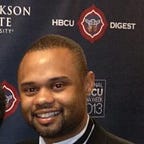How Nicholas Perkins won Howard Homecoming
School of Business shows the artistic, scientific potential of the HBCU financial ecosystem.
Nothing was going to be perfect for Nicholas Perkins that morning; too many folks standing way too still, too many of the tiniest elements missing from what was already an immaculate display greeting Howard Bison stepping off of the elevator at the Howard University School of Business’ top floor.
He, along with members of the Perkins Management Services Inc. team had been in Washington D.C. since Wednesday, filling out the last 72 hours with late nights and early mornings of set-up, adjustments and calls in preparation for a pre-kickoff, high noon start time during Howard Homecoming.
The squad was sponsoring the school’s annual alumni luncheon, an event with just as much value to Perkins as the dozens of other luncheons, dinners, banquets and other events he has orchestrated in the 11-years since beginning as a one-man operation, and growing into a multi-million company with holdings in food service, dry cleaning and health care in several cities throughout the country.
At that moment, the chocolate fountain still needed to be melted to the right temperature. A tray of crackers he asked about an hour ago was not yet on one of the tables. He was highly impressed with the ice sculptures, but they weren’t enough to cool off the 2013 H.U. Executive MBA grad. He hadn’t yet reached the point of yelling, but the thought had crossed his mind a few times.
It was 10:45 a.m.
Ten years ago, the National Center for Education Statistics published a report estimating the economic impact of HBCUs at just over $10 billion in 2001. More than 100 black colleges generated about $6 billion in institutional spending, and more than $4 billion in salary and benefit payments to more than 180,000 employees.
At the time, those employment numbers would’ve put the collective corporate influence of these schools in front of Bank of America as the nation’s 22nd largest employer.
Most economic impact studies are compiled on the financial benefit brought to a city or region by single events, or the compilation of conferences, sporting events and tourism in a city over a given period. One of the impact surveys with HBCU ties comes by way of the CIAA Basketball Tournament, which last year brought more than $50 million to Charlotte by way of its basketball tournaments, and this year will keep the good times rolling in the Queen City despite LGBT-hating legislation, cops shooting black folks, and lawmakers trying to close member institutions.
One tourism official I spoke with told me that it would be hard for HBCU events outside of the CIAA tournament or the Magic City Classic, estimated at $18 million in annual impact to Birmingham, to be gauged for a full view of how much money they bring to a city. Most visitors bureaus and tourism associations measure impact with a formula which starts with the a sampling of the number of hotel nights booked for a specific event, and that number is plugged into a calculator along with estimates of the amount of food and beverage, taxes, and other expenses associated with a person staying overnight in a city for a specific occasion.
Some cities are able to estimate raw numbers. Last year, Greensboro tourism officials estimated North Carolina A&T’s GHOE impact at $6 million. In Albany, estimates for Albany State’s homecoming were around $4 million.
But in all of these cases, schools typically are not partnering with tourism bureaus and municipal event planning groups to measure impact. They interface directly with folks who will make the school money, but not the entities which are making money off of people being there for the event.
Which is why Perkins, and dozens of other HBCU alumni who use homecoming as a backdrop for incubating business, are so important.
We may not know just how much money Howard Homecoming brings to Washington DC (the city’s tourism bureau does not keep official data on the event) by way of revenues for clubs, restaurants, parking, hotels, gas and taxes. But we do know that homecoming attracts thousands of students and visiting alumni who create some of the largest financial yields of the year for small business owners; those folks selling clothing and food as vendors on the yard, or who operate brick and mortar operations in vicinity to HBCUs (Shout out to Busboys & Poets, Ben’s Chili Bowl, and the entire U Street and 18th St corridors).
The throngs of people on any historically black campus whom we know are bringing value to the community in shopping, overtime pay earned by police officers securing them, tips earned by barbers and hair stylists in the days leading up to the homecoming, that is the impact that matters.
And with that, homecoming also serves as the setting for high-level engagement between schools, successful alumni and corporate representatives.
If most business deals are made on golf courses and at dinners, for black entrepreneurs and corporate liaisons, homecoming is a more than adequate stand in for 18 holes on a fall afternoon. It is the place where community and business mingle over drinks and laughs, with opportunity for students and institutions to gain as the desired outcome.
Sometimes it’s brown liquor in the glass, and the meetings serve as the informal vote for a president to be removed, or a campus contract to be illicitly awarded to a relative or family friend of an executive associate.
But when it works well, it is alumni and administration working together in benefit of the HBCU community.
And that’s what Howard Homecoming was for Nicholas Perkins and for the HU School of Business; a glimpse at how school and graduate, entrepreneur and entrepreneurial hub; work together to create more of the same.
And in case you were wondering how the party turned out?
